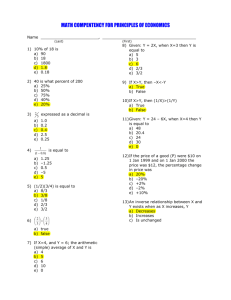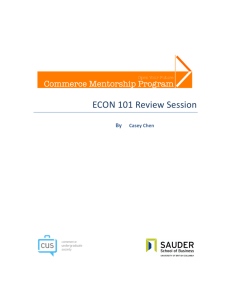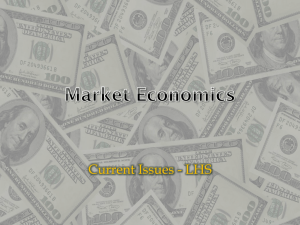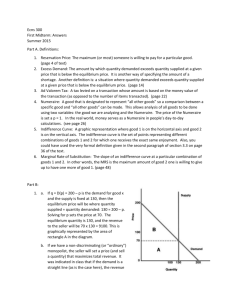agec 102 introduction to economics
advertisement
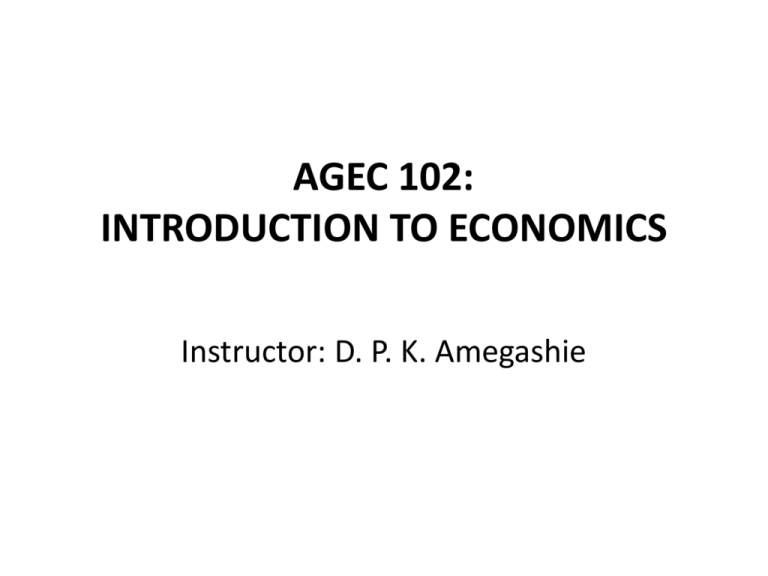
AGEC 102: INTRODUCTION TO ECONOMICS Instructor: D. P. K. Amegashie Objective To provide beginning students with the basic economic tools that will enable them appreciate the economic systems of the world and how an economy works COURSE OUTLINE PART 1: MICROECONOMICS • • • • • WHAT IS ECONOMICS? Scarcity and Choice Economic Systems Microeconomics and Macroeconomics Positive and Normative Economics Economics and Agricultural Economics • • • • TECHNIQUES OF ECONOMIC ANALYSIS Inductive and Deductive Reasoning Scientific Method of Enquiry Theory and Hypothesis Use of Graphs COURSE OUTLINE (cont’d) • • • • • ANALYSIS OF CONSUMER BEHAVIOUR Consumer Choice Concept of Utility Indifference Curves Budget Lines Consumer Equilibrium • • • • • DEMAND ANALYSIS Demand Schedule Demand Curve Demand Function Change in Quantity Demanded vs Change in Demand Factors Affecting the Demand for a Commodity COURSE OUTLINE (cont’d) • • • • • SUPPLY ANALYSIS Supply Schedule Supply Curve Supply Function Change in Quantity Supplied vs Change in Supply Factors Affecting the Supply of a Commodity • • • • ELASTICITY OF DEMAND AND SUPPLY Concept of Elasticity Price Elasticity of Demand and Supply Income Elasticity Cross Price Elasticity COURSE OUTLINE (cont’d) MARKETS • Types of Markets • Characteristics of Markets • Equilibrium of Competitive Markets • • • • THEORY OF THE FIRM (PRODUCTION ECONOMICS) Concept of Short-run and Long-run Fixed and Variable Inputs Concept of Cost Fixed and Variable Costs COURSE OUTLINE (cont’d) PART 2: MACROECONOMICS NOMINAL AND REAL VALUES IN ECONOMICS • Consumer Price Index (CPI) • GDP Deflator • Purchasing Power • • • • • NATIONAL INCOME DETERMINATION Gross Domestic Product (GDP) Gross National Product (GNP) Consumption Function Savings Function The Multiplier Measurement Problems COURSE OUTLINE (cont’d) INFLATION • Level of Inflation • Rate of Inflation UNEMPLOYMENT • Rate of Unemployment • Labour Force Reference Texts: 1. Kojo Appiah-Kubi (2008): Principles of Macroeconomics, Sundel Services, Accra 2. Ruffin, R. J. and Gregory, P. R. (1988): Principles of Economics. Scott, Foreman and Co. Boston, U. S. A. 3. McConnell Campbell R & Brue, Stanley L (1999): Microeconomics 14th Edition. The McGraw-Hill Companies , U.S.A. 4. Samuelson, Paul A & Nordhaus, William D (1998): Macroeconomics 16th Edition. The McGraw-Hill Companies , U.S.A. 5. Adeegeye, A. J, and Dittoh, J. S. (1985): Essentials of Agricultural Economics. Impact Publishing Nig Ltd. Ibadan Mark allocation: Continuous assessment Examination Total = = = 30% 70% 100% There will be two Interim Assessments (6th and 12th weeks) and unannounced quizzes GRADING SYSTEM: • • • • • • • • • A B+ B C+ C D+ D E F = = = = = = = = = 80 – 100% 75 - 79 70 - 74 65 - 69 60 - 64 55 - 59 50 - 54 45 - 49 0 - 44 PART 1: MICROECONOMICS WHAT IS ECONOMICS? • Human beings are plagued with wants. • We need air, water, food, clothing, and shelter. • We also seek the many goods and services associated, with a comfortable or affluent standard of living. • The total of all our material wants is many times greater than the productive capacity of our limited resources. • Thus the complete satisfaction of material wants is impossible. • This unyielding reality provides our definition of Economics. WHAT IS ECONOMICS? (Cont’d) • Economics may be defined as: the study of the use of scarce resources to produce goods and services to satisfy unlimited human wants. • Alternatively, it is the study of the ways in which human beings allocate relatively scarce resources among competing uses. • Economics can aptly be described as the science of choice. Scarcity and Choice • An item is a scarce good if the amount available is less than the amount people would want if it were given away free of charge. • Alternatively, a resource is said to be scarce when the use of it by one person reduces its availability to others. • The scarcity of resources is relative and exists only because the supply of resources (land, labour, capital, management) is limited, while the ways in which resources can be used are literally infinite (limitless). • Choice is the act of making a selection among alternative goods, services or actions. • Since resources are scarce (or limited) it follows that the goods and services we produce must also be scarce. • Scarcity limits our options and necessitates that we make choices, because we cannot have all that we want. There is no ‘free lunch’. Scarcity and Choice (Cont’d) • If human desires were to be fully satisfied, • people would not worry about stretching out their limited incomes because they could have everything they wanted; • businesses would not need to worry over the cost of labour or health care; • governments would not need to struggle over taxes or spending, because nobody would care. • Moreover, since all of us could have as much as we pleased, no one would be concerned about the distribution of incomes among different people or classes. • In such an Eden of affluence, there would be no economic goods, that is, goods that are scarce or limited in supply. All goods would be free, like sand in the desert or seawater at the beach. Prices and markets would be irrelevant. Indeed, economics would no longer be a useful subject Economic Systems • An economic system is a set of organisational arrangements and institutions that are established to solve the economic problems of what to produce, who to produce, and for whom? Economic systems differ as to: 1. who owns the factors of production, and 2. The method used to coordinate and direct economic activity. • On this basis, the following economic systems are identified: 1. Pure capitalism 2. The command economy, 3. Mixed systems, and 4. The traditional economy. 1. Pure Capitalism: • Pure Capitalism is characterized by private ownership of resources and the use of a system of markets and prices to coordinate and direct economic activity. • It is otherwise known as the laissez-faire capitalism. • Individuals and private firms make the major decisions about production and consumption. • The government keeps its hands off economic decisions. • A system of prices, of markets, of profits and losses, of incentives and rewards determines what, how, and for whom. • Firms produce the commodities that yield the highest profits (the what) by the techniques of production that are least costly (the how). • Consumption is determined by individuals’ decisions about how to spend the wages and property incomes generated by their labour and property ownership (for whom). • The result is competition among many small, independent acting buyers and sellers of each product and resource 2. The Command Economy: • The Command Economy (or communism) is the polar alternative to pure capitalism. • It is characterised by public (or government) ownership of virtually all property resources and economic decision making through central economic planning (planned economy). • All major decisions concerning the use of resources and distribution of output are determined by a central planning board appointed by government. • Planned systems have the ability to adapt to change provided that those who do the planning do not suffer from economic myopia. 3. Mixed Systems This is a system that exists in real world economics between the two extremes of Pure Capitalism and the Command Economy, resulting in various degrees of private ownership and state interventions in the operations of the market. The emergence of the mixed economic systems is due to reforms of the two extreme economic systems overtime. 4. The Traditional Economy: • This is probably the oldest economic system in which consumption, production and distribution of income are all sanctioned by custom (i.e. handled by procedures developed in the past, perfected by trial and error, and institutionalized by repeated use). • The basic economic questions are answered by the simple technique of duplicating the past. • For example: Tradition may dictate that the young men of a tribe provide food for those too old to go hunting. Custom may require that, in return, the aged make the weapons for the hunt. • Traditional economies are stable, since they do not have the ability to adapt to change. Microeconomics and Macroeconomics • Micro economics is the study of how individual producers (or firms/businesses) and consumers (households) decide on how to use the scarce resources to produce, consume and exchange in individual markets. • It attempts to answer questions about: • i. • ii. • iii. How the individual producer can minimise costs of production and maximize profits; How the individual consumer can maximize his or her utility or satisfaction; and How producers and consumers react to economic situations and how these reactions determine resource allocation, outputs, distribution of income and the prices to be charged for goods and services Microeconomics and Macroeconomics (Cont’d) • Macroeconomics, on the other hand, is the study of how society as a whole decides on how to use scarce resources to produce, consume and exchange in the market. It explains the economy as a whole rather than individual producers, consumers, and markets. All producers are grouped together to study total investment spending and total production; all consumers are grouped together in examining total consumption spending. • Hence, a study of aggregate economic behaviour of the economy. • Its concepts are used to analyse, among other things, aggregate output, aggregate demand and supply, aggregate consumption, inflation and unemployment in an economy as a whole. Positive and Normative Economics • Positive economics is the study of what is in existence, and explains the existing economic conditions. • It deals with facts and avoids value judgement. • For example: Economists generally agree that rising prices reduce consumption (ceteris paribus); • they agree that the price of maize rises when there is drought; etc. • Questions can be resolved by reference to analysis and empirical evidence. • Normative economics is the study of what should be done (or ought to be done) in an economic situation. • It tends to be ‘prescription’ and/or policy-oriented. Positive and Normative Economics (Cont’d) • There are no right or wrong answers to questions because they involve subjective (or someone’s) value judgement about what the economy should be like or what particular policy should be recommended; and can only be resolved by political debate and decisions. • For example: Economists disagree on whether we should have more employment or more inflation; they disagree over whether income taxes should be lowered for the middle class, the rich, or the poor; they disagree on whether free market is the best way to meet the material needs of consumers; etc. • Statements involving the word ‘ought’ or ‘should’ in the sentence denote normative statements. Economics and Agricultural Economics • Agricultural Economics is defined as an applied social science dealing with how humans choose to use technological knowledge and scarce productive resources such as land, labour, capital and management to produce food and fibre and to distribute it for consumption to various members of society over time. • It is, therefore, the application of economic principles to agriculture. It is concerned basically with resource allocation in the agricultural industry. • Agricultural Economics as a separate discipline from Economics arose out of the importance of food and other agricultural products for human existence and also from the need to take an in-depth look at agricultural production at a micro level. TECHNIQUES OF ECONOMIC ANALYSIS Inductive and Deductive Reasoning • Inductive reasoning is the scientific method of studying economic behaviour in which the economists accumulate facts, arrange them systematically, and analyze them to permit the derivation of a generalization (or theory). • The economists move from facts to theory or from the particular to the general. • Deductive reasoning, on the other hand, is the scientific method of studying economic behaviour in which the economists develop a tentative untested principle (called hypothesis), which is tested against facts. (e.g. ‘If income rises, people will consume more’). • The economists move from theory to facts in studying economic behaviour. Inductive and Deductive Reasoning (Cont’d) • To develop a hypothesis economists draw upon casual observations, insight, logic, or intuition. • To test the validity of the hypothesis, the economists must subject it to systematic and repeated comparison with relevant facts. • Generalizations derived from either method are useful not only in explaining economic behaviour but also as a basis for formulating economic policies. Scientific Method of Enquiry • The Scientific Method is the process of formulating hypotheses, and collecting data through observation and experimentation to test these hypotheses. • Scientific researchers propose hypotheses as explanations of phenomena, and design experimental studies to test these hypotheses. • These steps must be repeatable, to predict future results Theory and Hypothesis • Every experiment in science is aimed at testing a hypothesis which validates it into a theory. • A hypothesis is a tentative assumption made in order to test its logical or empirical consequences. It is only a conjecture or an assumption which may possibly be the right explanation, if it fits all the facts, but cannot be established until an experiment proves it. It is one of the most important steps of the scientific method of enquiry. • A theory is a plausible and coherent explanation of how certain facts are related; and has been validated through experimental verification or observational evidence to reflect economic reality. Theory and Hypothesis (Cont’d) • Theory is known to be consistent with all associated experimental facts and can successfully predict the behaviour of a system under consideration. • While a hypothesis is an unvalidated statement intended to explain why something happens or exists, a theory is an established or a validated explanation of a phenomenon (why things happen or exist the way they are). • In short, a hypothesis is a possibility; while a theory is a possibility, which has graduated to become a fact. Use of Graphs • A graph is a pictorial representation of the relationship between two or more sets of data or variables. • Economists often use graphs to illustrate relations between economic variables, such as income and consumption, because it gives a better understanding of economic relationships. • Some graphs show how variables change over time (trend), while other graphs show the relationship between different variables: • Most economic principles or models explain relationships between just two sets of variables, which can conveniently be represented with twodimensional graphs. • For example: Income and consumption; price and quantity of good sold or price and quantity of good bought. Use of Graphs (Cont’d) • There are various types of graph including: Line graphs, Bar Charts, Pie Charts, Scatter Diagram, etc. • If the graph is a straight line the relationship is said to be linear. • If the line slopes upward to the right it depicts a direct relationship between the two variables (or there is a positive relationship). • This means that both variables change in the same direction. • In contrast, two sets of data may have inverse or negative relationship because the two variables change in opposite directions. Dependent and Independent Variables • An independent variable is the cause or source variable; it is the variable that changes first. (e.g. income) • The dependent variable is the effect or outcome; it is the variable which changes because of the change in the independent variable. (e.g. consumption) • Economists usually, but not always, place the independent variable (income) on the horizontal axis and the dependent variable (consumption) on the vertical axis of the graph ‘Other Things Equal’ • Factors other than the independent variable (cause variable) might affect the dependent variable. • When economists plot the relationship between two variables, they assume other things equal. (i.e. • That is the ceteris paribus assumption, implying that all other factors are assumed to be constant or unchanged. • In reality, ‘other things’ are not equal; they often change, and when they do, the relationship represented will change. Slope of a Line • The slope of a straight line is the ratio of the vertical distance the straight line travels between any two points (rise or drop) to the corresponding horizontal change (the run). i.e. Rise (or drop) Run • The slope is used to describe the relationship between two variables. • A positive slope shows that the two variables are directly or positively related; while • A negative slope implies that the variables are inversely or negatively related. Slope of a Line (Cont’d) • When variables are independent of one another or unrelated, the slope is either infinite or zero. • An infinite slope exists when the graph of their relationship is parallel to the vertical axis, indicating that the same quantity of the dependent variable exists no matter the change in the independent (or causal) variable. • Similarly, a zero slope exists when the relationship is a line parallel to the horizontal axis, indicating lack of relatedness. Vertical Intercept • The vertical intercept of a line is the point where the line meets the vertical axis. • This intercept means that if independent variable is zero the dependent variable will not be zero. • E.g. If current income were zero, consumers would still be spending through borrowing or by selling off some of their assets. Equation of a Linear Relationship • If the vertical intercept and slope are known a line can be described succinctly in equation form. • In its general form the equation of a straight line is: Y = a + bx where Y = dependent variable a = vertical intercept b = slope of line x = independent variable Slope of a Nonlinear Curve • The slope of a nonlinear curve at a given point is the slope of a straight line that just touches, but does not intersect, the curve at the point of contact. • Such a straight line is called a tangent to the curve. • While the slope of a straight line is the same at all points, the slope of a nonlinear curve changes from one point to another. Graphs Y Y Slope = positive Slope = negative intercept X X Graphs (Cont’d) Y Y Infinite Sslope Zero Slope X X Y A Slope of Curve at point A X ANALYSIS OF CONSUMER BEHAVIOUR • Consumer Choice • Consumers spend their incomes on a variety of goods and services; but the consumer is limited in the amounts of goods he can buy due to his limited income and the price tag on each good. • The consumer must, therefore, select or choose the most satisfying basket of goods and services among alternatives. • Consumer Choice (Cont’d) • The analysis of consumer choice is based on the assumptions of rational behaviour and preferences of consumers as follows: that: 1. The consumer makes rational decisions by trying to use his or her money income to derive the greatest satisfaction from it. 2. Each consumer has a set of well-defined preferences for goods and services available in the market. The consumer must be able to rank different baskets of goods and services to determine the order of preference among them. i . For any two baskets of goods A and B, either A is preferred to B (A˃ B); B is preferred to A (A ˂ B); or the consumer is indifferent between A and B (A ≡ B). ii. Preferences are transitive. That means if A is preferred (or indifferent) to B and B is preferred (or indifferent) to C, then A is preferred (or indifferent) to C i.e. A˃ B; B˃C, then A˃ C ; A ≡ B; B ≡ C, then A ≡ C 3.Each consumer has a fixed, limited amount of money income at any point in time. Thus, all consumers face a budget constraint. 4.Every good and service carries a price tag and each consumer can purchase only a limited amount of goods because of his or her limited income and the prices of products • Concept of Utility • Utility is the satisfaction that a person enjoys or derives from the consumption of goods and services. A given collection of goods gives a certain level of utility. If another collection gives a higher level of utility then that collection is preferred to the first. • A consumer is indifferent between the two collections of goods if they both give him the same level of utility. While a consumer can tell which of the two baskets of goods he prefers based on the utility derived, he cannot communicate how much utility is derived. This means that utility cannot be measured. It is purely subjective depending on the individual consumer • Indifference Curves • An indifference curve is a graph which shows all alternative combinations of two goods that yield the same level of total satisfaction (or total utility) to a consumer and among which the consumer is indifferent. It tells us how much of one good a consumer is willing to give up in trade for one unit of another good without experiencing a loss in total satisfaction (i.e. substitution of one good for another). An Indifference Schedule Combination Units of X (e.g fish) Units of Y (e.g kenkey) A 1 6 B 2 3 C 3 2 D 4 1 An Indifference Curve Y 6 3 2 1 I 0 1 2 3 Quantity of X 4 An Indifference Curve (Cont’d) • Every point on the curve I represents some combination of goods X and Y, and all those combinations are equally satisfactory to the consumers. That is, each combination of X and Y on the curve yields the same total utility. Indifference Map • A set of indifference curves reflects different levels of total utility and is called an indifference map. Curves farther from the origin indicate higher levels of total utility. Thus, any combination of X and Y represented by a point on I3 has greater total utility than any combination of X and Y represented by a point on I2 and I1 Indifference Map Y I3 I2 I1 0 1 2 3 4 X Properties of Indifference Curves 1. They are downward sloping because more of one product demanded by a consumer implies less of the other product if total utility is to remain the same. 2. An indifference curve is convex to the origin because the quantity of a product that a consumer is willing to give up to obtain an additional unit of a second product diminishes as more units of the second product are added. This means that it has a diminishing slope or diminishing marginal rate of substitution. 3. The consumer is better off as he moves up to a higher indifference curve 4. Curves do not intersect. 5. An indifference curve does not move (or shift) as a result of marginal changes in income or prices Properties of Indifference Curves Y A D E C B 0 1 2 3 I = 2000 I =1000 4 X Budget Lines • A consumer’s budget is an estimate of what he can buy with his income. A budget line shows all the combinations of two goods that a consumer can buy with a particular money income and given prices of the goods. Budget Lines (Cont’d) • For two goods X and Y with known prices Px and Py respectively, and income M (to be spent completely), the budget equation can be expressed as: Px. X + Py. Y = M Py Y = M – Px.X Y = M/Py - Px/Py. X budget line • This is a straight line with M/Py as intercept and –Px/Py as slope of the budget line • Hence slope of budget line equals ratio of prices Budget Lines (Cont’d) M/Py -Px/Py (unattainable) Y (attainable) X Budget Lines (Cont’d) 1. The budget line has a negative slope equal to the ratio of product prices i.e. Change in Y/Change in X = -Px/Py. Negative slope implies that buying more of one good results in buying less of the other good if M is constant 2. An increase in(or decrease) in the money income of the consumer will shift the budget line to the right (or left) without affecting its slope 3. An increase (or decrease) in the prices of both products shifts it to the left (or right). 4. An increase (or decrease) in the price of the product whose quantity is measured horizontally (the price of the other product remaining constant) the lower end of the line turns clockwise (or anticlockwise) Consumer Equilibrium • Consumer equilibrium is the utility maximizing combination which lies on the highest attainable indifference curve. The rational consumer wants to get to the highest indifference curve, given the budget constraint. At this point the budget line is tangent to the indifference curve. (Tangent is a straight line that touches a curve but does not cross it). • The indifference curves show how the consumer ranks different market baskets; the budget line shows what the consumer is able to buy. Combining the information represented by the indifference curve and the budget line shows what combination the consumer will buy. • That is, Slope of budget line = slope of indifference curve. Consumer Equilibrium (Cont’d) Y e I3 I2 I1 X Consumer Equilibrium (Cont’d) Slope of Budget line = Px Py • Slope of the indifference curve = marginal rate of substitution (MRS) of one good for the other • The consumer is in equilibrium where MRS = -Px/Py • The marginal rate of substitution is equal to the price ratio DEMAND ANALYSIS • Demand is the amount of a good that people are willing to buy under specified circumstances at a given point in time. There exists a definite relationship between the market price of a good and the quantity demanded of that good, other things held constant. This relationship is represented differently as the demand schedule, demand curve or demand function. . Demand Schedule Demand schedule can be defined as a table that shows the quantities of a product that a consumer is willing to buy at various prices at a specified period of time • A Hypothetical Demand Schedule for Plantain Price per kg Individual Individual Individual Market A B C (Total) 2 20 20 10 50 4 15 10 6 31 6 10 5 3 18 8 8 1 1 10 10 4 0 0 4 Demand Schedule (Cont’d) • When price is raised buyers tend to buy less of the plantain, hence negative (or inverse) relationship. The market demand is the horizontal summation of the demands of all individual in the market for that good. Demand Curve • Demand curve is a graphical representation of the relationship between quantity demanded and price of a product P/kg 10 8 6 4 2 0 • • 5 10 15 20 Kg of Plantain 5 10 15 20 5 10 15 10 20 30 40 50 Demand Function • The demand function is the algebraic (or symbolic) representation of the price-quantity relationship of demand. • Qd = f(p) • (Read as Qd equals ‘f of p’which means Qd is a function of p or Qd depends on p) • Where Qd is the quantity demanded p is the unit price f is a functional notation. Demand Function (Cont’d) • Other letters can be used to denote a function e.g. D (p), g(p), etc. • • It can be shown that quantity demanded of a good is a function price and other factors that also determine demand • • Qd =f (p u, v, x, y, z) • • Where u, v,x,y,z are other factors. • Very often in order to simplify analytical understanding the quantity demanded is looked at only in relationship with price with all the other determinants held constant (i.e ceteris paribus). Change in Quantity Demanded vs Change in Demand • Quantity demanded is the amount of a good people are willing to buy at different prices at a given point in time, other things being equal. A change in quantity demanded is the increase (or decrease) in the quantity of good to be purchased in response to a price decrease (or increase) of that good. It depicts a movement along a given demand curve from one point to another. It is downward moving when there is a decrease in price and vice versa. • A change in demand is a shift of the entire demand curve to the right (an increase) or to the left (a decrease). It occurs when there is a change in one or more of the determinants (factors) of demand, other than price.; e.g. income. Factors Affecting the Demand for a Commodity • The quantity demanded of a product cab be influenced by several factors which can be classified into price and non-price factors. The non-price factors may include: 1. The price of related goods (substitutes such as beef and chicken; and complements such as gari and beans) 2. The level of income 3. Tastes, Religion, Fashion and Preferences 4. Price expectations of consumers 5. Number of buyers (Population) 6. Government Policy (e.g. reduction in taxes, increase in subsidies, restrictions, etc) 7. Weather conditions and seasons 8. Inventions and innovations SUPPLY ANALYSIS • Supply is the amount of a good that producers are willing to offer for sale under specified circumstances at a given point in time. There exists a definite relationship between the market price of a product and the quantity supplied of that product, other things held constant. The supply relationship is also represented differently as the supply schedule, supply curve or supply function.
